A video API is a powerful tool that enables developers to integrate video-related features into applications and websites. By using a video API, you can add functionalities like live streaming, video playback, video recording, and real-time video communication without needing to build these complex systems from scratch. These APIs often provide extensive documentation, developer-friendly SDKs, and a variety of customization options, making it easier to create seamless video experiences that engage users. Whether you’re developing a video conferencing app, a streaming platform, or an educational portal, a video API helps you deliver high-quality video content and enhance user interaction.
What is a Video API?
A Video API, or Application Programming Interface, serves as a toolkit for developers to integrate video-related functionalities into their applications or platforms seamlessly. Essentially, it provides a standardized way for software components to communicate and interact with video services programmatically.
With a Video API, developers can incorporate features like live streaming, recording, playback, and video conferencing into their applications without needing to build these capabilities from scratch. These APIs offer a range of functionalities, including facilitating video streaming, recording, playback, conferencing, analysis, and encoding/transcoding tasks. By leveraging Video APIs, developers can enhance user experiences, streamline development processes, and unlock new possibilities for innovation across various industries and applications.
Different Types of Video APIs
Video APIs come in various types, each designed to serve specific functionalities and use cases. Here are three key types of video APIs that can enhance your application:
1. Video Streaming API
A video streaming API enables developers to integrate live or on-demand video streaming into their applications. These APIs handle encoding, delivery, and playback of video streams, ensuring smooth transmission and minimal latency. They’re commonly used in video conferencing, live sports events, and interactive broadcasts, providing the tools needed to set up, manage, and scale streaming infrastructure without building it from scratch.
2. Video Platform API
Video platform APIs are designed to connect with a broader video hosting and content management ecosystem. These APIs allow developers to upload videos, organize them into playlists, set permissions, and retrieve analytics data. They are often used by content creators, media companies, and e-learning platforms that rely on video as a core component of their offerings. With these APIs, developers can integrate robust video content workflows and leverage the host platform’s built-in features.
3. Video Player / Client-Side APIs
Client-side video player APIs control how video content is rendered in a user’s browser or application. They provide functions to play, pause, seek, adjust volume, and modify playback settings. In addition, these APIs often support customizing the player’s interface, adding overlays, or integrating captions. Client-side APIs ensure a seamless viewing experience for end-users and are key to creating user-friendly video interfaces.
When Would a Video API be Necessary?
A video API is necessary when you need to integrate video functionality into your application or platform without building everything from scratch. It’s especially useful for features like live streaming, video playback, recording, or real-time video calls. Instead of investing time and resources in developing a video solution from the ground up, you can use a video API to quickly and efficiently implement these capabilities. This approach ensures high-quality video experiences while allowing developers to focus on other aspects of the product.

Benefits of a Video API
The benefits of a video API are multifaceted and can greatly enhance the functionality and user experience of applications across various industries. Here are some key advantages:
- Enhanced User Engagement: Video content is inherently more engaging than text or images, and integrating video capabilities through an API can significantly boost user engagement. Whether it’s through live streaming, video calls, or interactive video elements, users are more likely to spend time on an application that offers rich multimedia experiences.
- Improved Communication: Video APIs enable real-time communication through features like video calls and conferencing. This facilitates more effective collaboration among team members, clients, or customers, regardless of their geographical location. It can also enhance customer support experiences by providing face-to-face interactions.
- Scalability and Flexibility: Using a video API allows developers to leverage the infrastructure and resources of the API provider, leading to scalability and flexibility in handling varying levels of traffic and demand. Developers can easily scale video capabilities up or down based on usage patterns without having to manage complex infrastructure themselves.
- Time and Cost Savings: Developing video capabilities from scratch can be time-consuming and costly. Video APIs provide pre-built solutions for common video-related tasks such as streaming, recording, and playback, saving developers valuable time and resources. This allows them to focus on building unique features and functionalities specific to their application.
- Cross-Platform Compatibility: Video APIs often offer cross-platform compatibility, allowing applications to deliver consistent video experiences across different devices and operating systems. This ensures that users can access video content seamlessly regardless of the device they are using, enhancing accessibility and user satisfaction.
- Security and Compliance: Many video APIs come with built-in security features such as encryption and access controls to protect sensitive video content and ensure compliance with data privacy regulations. By leveraging these security features, developers can mitigate security risks and safeguard user data.
- Analytics and Insights: Video APIs often provide analytics and reporting tools that enable developers to gain valuable insights into user behavior, engagement metrics, and performance metrics. This data can be used to optimize video content, improve user experiences, and make informed business decisions.
How Does a Video API Work?
A video API serves as a connector between developers’ applications and video services, facilitating the smooth integration of video-related functionalities. Initially, developers integrate the API into their applications by incorporating its libraries, and SDKs, or by making direct API calls within their code. Once integrated, users authenticate themselves with the API, granting access to video services securely. Parameters such as video quality, streaming protocols, and encryption settings are then set up within the application.
Following initialization, developers can utilize a range of functions provided by the video API. These functionalities include initiating video streams, recording video content, playing back recorded or streamed videos, and conducting video conferences. The application communicates with the video API’s servers over the internet to execute tasks like streaming video data, storing recorded content, or transmitting video calls. Throughout this process, the API may provide feedback to the application, confirming successful video uploads, notifying errors, or supplying real-time metrics like bandwidth usage or viewer engagement.
10 Best Video API Providers for Business
Upon searching for the best streaming video API, a list of API tools will appear in front of you. Thus, you will automatically get double-minded while choosing the option that aligns with your requirements and objectives. To make things easier, we have drafted the 10 best video APIs.
1. ZEGOCLOUD
Start building your video call applications with minimal hassles; ZEGOCLOUD is a trusted solution by over 4000 businesses worldwide. With this video chat API, you can quickly integrate video call functionality into existing applications without the need to code from scratch. For an enhanced user engagement and fully immersive experience, ZEGOCLOUD delivers video calls in a crisp 4K resolution that is backed with 300ms low latency.
The best part is users can create large video call conferences without any problem because this video API can support up to 10,000 participants in a single call. Subsequently, for developers, there is a facility for documentation, tutorials, and support services to make things easier to process.
Key Features
- Users can do live streaming of their important content through screen sharing, perform co-hosting, and even record the entire session.
- With the availability of virtual backgrounds, face beautification, and super-resolution support, your video call becomes creative and special.
- This video API comes with cross-platform support that allows users to interact on the Web, Android, and iOS operating systems.
2. Twilio
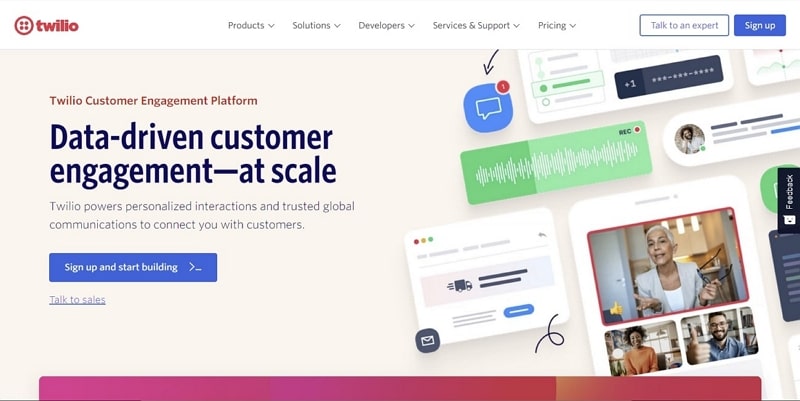
Build your video call application with minimal resources and effort, thanks to Twilio API for video, an ideal solution for developing personalized communications with innovation. Although this API is paid, it allows you to start for free as a new user so that you can build your first application without charge. As a developer, Twilio API is a great assist that offers quick integrations for solutions like video, messaging, voice, and email.
Meanwhile, the API possesses customized solutions for business sectors like marketing, engineering, healthcare, retail, etc. In addition, Twilio is trusted by top brands like Allergan, Natwest, Doordash, and more.
Key Features
- You can easily customize features and functionalities as per your business demands.
- Twilio is developed on WebRTC technology, providing a stable platform with top-notch video call experiences.
- It also allows you to utilize quality control tools for monitoring the network’s performance.
3. Sinch
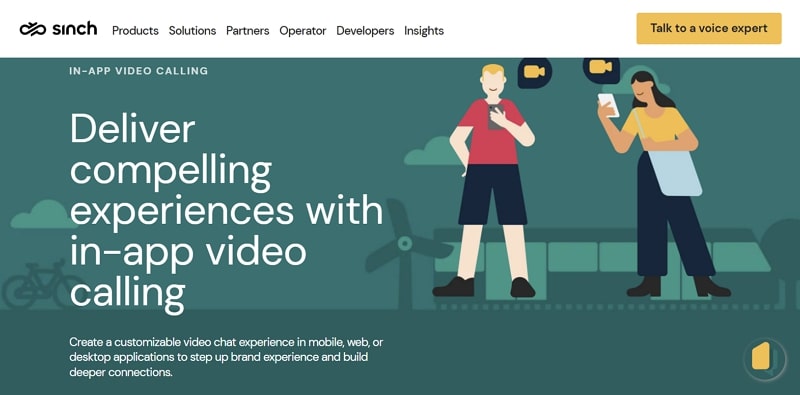
Sinch is your trusted solution for developing a fully customizable video API for web, mobile, or desktop applications. This API provides a seamless video-calling experience with extraordinary audio support and no unnecessary disruptions. Thanks to its easy-to-understand GUI that helps make managing and integrating APIs simpler for all developers.
With the available detailed documentation, developers of all levels are given brief knowledge and ways to start the integration process. Thanks to 24/7 connectivity support, the servers are active throughout, and you won’t be disconnected from your call anytime, anywhere.
Key Features
- With peer-to-peer communication, send all the data to the receiver without compromising quality.
- Take screen controls into your hand with effects like blur faces, bunny ears, and more.
- The cross-platform support allows you to connect and call anyone, irrespective of the platform.
4. MirrorFly
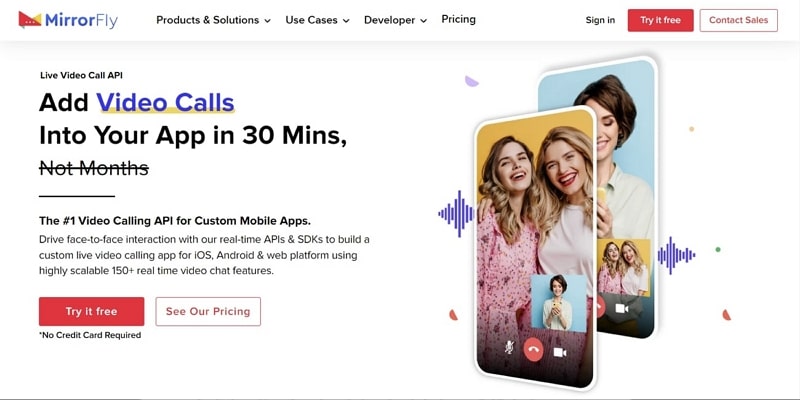
Taking video call experiences to the next level, MirrorFly is an industry-leading API for web and mobile applications. Subsequently, this streaming video API leverages over 150 real-time functionalities that drive face-to-face interactions in a more organized way. Meanwhile, the platform is easy to use, which makes it easier for the developers to handle and manage tools, resources, and widgets to execute API integrations efficiently.
Interestingly, this video API is built on WebRTC technology, which ensures uninterrupted video calls with clear and crispy quality. As a new user, start building your video call application on a first free trial and experience an unmatchable quality.
Key Features
- The pre-built UI Kit could be modified to add functionalities like whiteboarding, recording, streaming, etc.
- You can use this API to build an app for organizations such as Education, Healthcare, Gaming, Enterprise, and Financial Services.
- From app design to API implementation, you have the support of 300+ professionals to guide and support you.
5. Agora
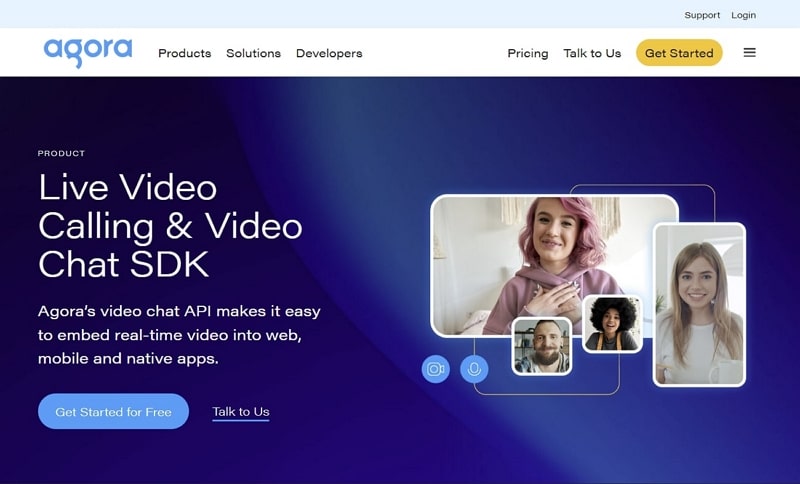
Building real-time video call applications is now easier, smarter, and more secure with Agora video API, which conveniently drives real-time engagement. Furthermore, this fully modifiable API allows you to personalize it according to your brand’s goals and within the desired features. With cross-platform support, you can quickly build your application and go live to the market faster.
As a developer, irrespective of your level and skills, there’s a facility of documentation with step-by-step approaches to get started with app integrations. With a simple line of codes and other clickable tools, the final app is ready in a quick time.
Key Features
- Supports wide functionalities like video calling, voice calling, message chat, whiteboard, streaming, and more.
- With AI noise suppression and 3d spatial audio, experience a fully immersive sound quality with a clear voice.
- By utilizing the Agora analytics tool, monitor and improve the quality of video calls by detecting issues and solving them.
You may also like: Top 10 Agora SDK Alternatives & Competitors
6. Apphitect
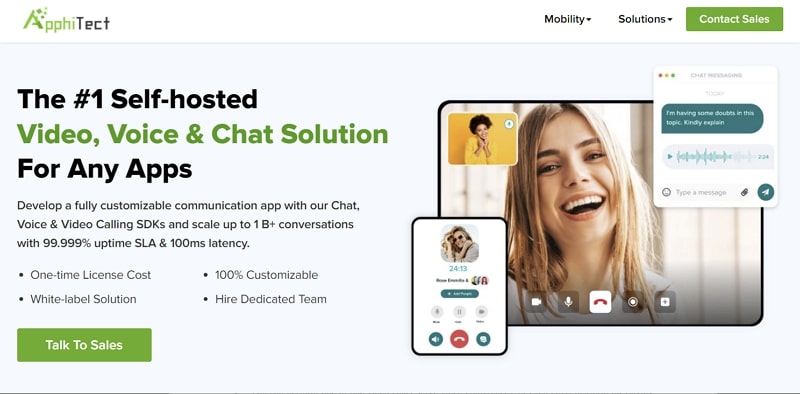
Meet Apphitect, an industrial standard streaming video API that helps businesses and enterprises build video chat applications while saving time and money. Moreover, this API has everything embedded in it, as you can perform video calls, audio chats, and text messages in a real-time scenario.
Furthermore, this API is an excellent facility for developers as it allows easy access to a range of tools and technologies that ensure streamlined app development. Meanwhile, the API supports conversational possibilities in all sectors, including gaming, health, banking, education, and more. With the scalability options, promote app engagement within the features you want.
Key Features
- Apphitect API is backed with security measures like E2E encryption, HIPPA, AES26, and GDPR compliance.
- With this video chat API, you can perform one-to-one video chats, large video conferences, or even cross-platform messaging.
- Screen sharing, whiteboard, and language translation support features can enhance maximum participant engagement.
7. PubNub
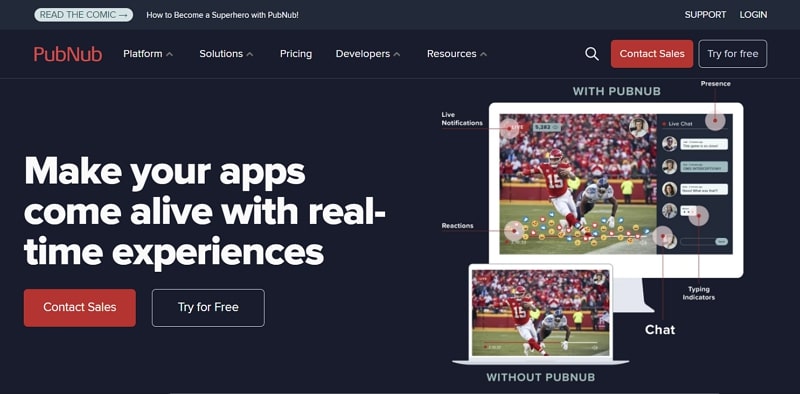
Make video calling come alive with real-time experiences at PubNub, an industrial-grade video API that offers API support for over 50 mobile, web, and IoT environments. Moreover, this API comes with over 65 pre-built UI kits that could be integrated into your applications with zero hassles while bringing tons of essential communication facilities to your app.
PubNub has a 99.999% uptime SLA, making it a stable API without interruptions and downtime errors. Moreover, it has in-detailed tutorials, demos, and documentation to make app integration easier for developers.
Key Features
- Build customized apps that are tailor-made to your business goals without having tensions of infrastructure issues.
- Don’t worry about data privacy because PubNub complies with SOC2 Type 2, ISO 27001, HIPAA, GDPR, and CGPA.
- With the file-sharing options of this API, you can also upload and share files and documents without any problem.
8. EnableX
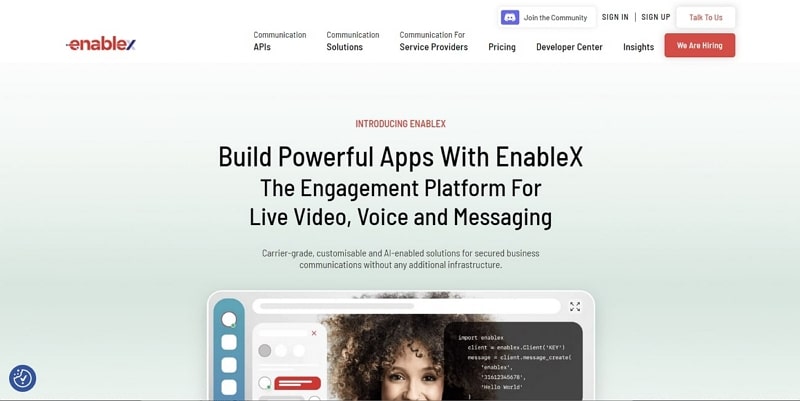
Building powerful video chat apps in a quick time is possible with EnableX live video API; you can now make personalized communication facilities to connect. With this API, you cannot only perform video calls with your loved ones, but it also supports audio calls alongside in-app chat leverage. With an intuitive overall display and easy navigation, this video API isn’t difficult.
Being a developer, you’ve got the option to build applications using the programming language of your choice. Moreover, you can also use Visual Builder to develop apps using drag-and-drop features.
Key Features
- With EnableX Cloud support, perform all your communication tasks without the problems of physical infrastructure.
- Due to the Emotion AI technology of this API, you can read another person’s facial expressions on-call based on their mood.
- This video chat API allows you to scale your video communications with future-proof infrastructure that is both reliable and fast.
9. Vonage
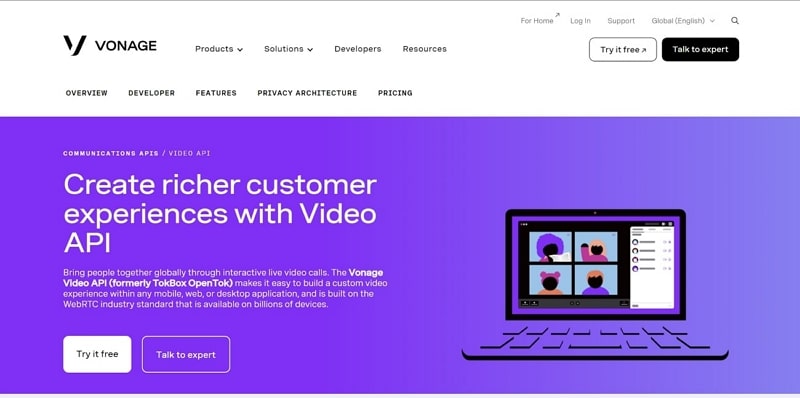
Accelerate your connections with meaningful interactions with Vonage video API, a powerful yet efficient video API integration. Thus, you can custom-make your video call applications without coding from scratch, as Vonage APIs offer dedicated resources, packages, and tools.
Similarly, this API aids all developers with hassle-free integrations with the availability of developer docs and programmable solutions. While using WebRTC standards, all your video call sessions remain stable and uninterrupted, which you can access on different web browsers, mobile devices, and even desktops.
Key Features
- Screen sharing is a possibility by which host or even participants can share their screens for user engagement.
- You can modify the video streams using filters, effects, AR/VR, and more.
- With the analytics facility, review the data insights from video calls, account dashboards, and APIs themselves.
You may also like: Best 5 Vonage Alternatives & Competitors
10. QuickBlox
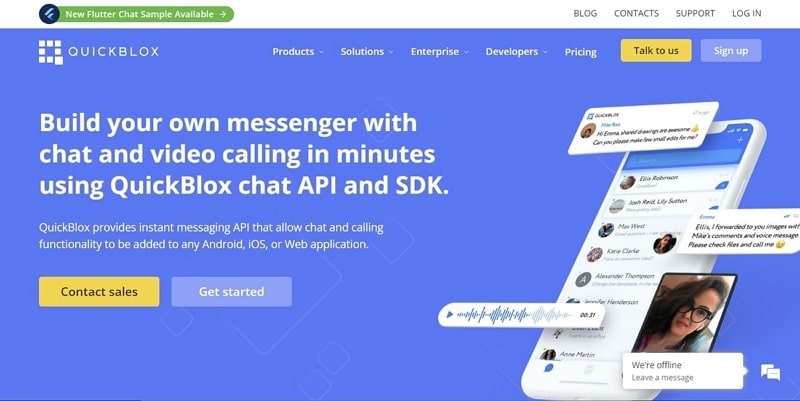
QuickBlox is a leading streaming video API that offers instant video chat integrations into Web, iOS, or Android applications. Therefore, businesses can quickly produce video chat applications with modern features in less time. This way, developers don’t need to waste time building apps from scratch so that they can focus on more useful tasks.
Moreover, with the available documentation, developers are provided with step-by-step insights to implement video and calling facilities in real-time. Since there is cross-platform support, you have a facility for multiple programming languages and frameworks.
Key Features
- You can also manage the participants present in a video call by muting and unmuting them to avoid unnecessary noises.
- With flexible data storage options, your privacy is protected from unnecessary customizations or hacker threats.
- It has multiple advanced features like push notifications, file sharing, and screen sharing.
Future Trends in Video API Technology
The landscape of video API technology continues to evolve, driven by advancements in streaming protocols, video compression, and real-time communication. One major trend is the growing focus on ultra-low latency, enabling near-instantaneous interactions for applications like live gaming, virtual events, and telemedicine. Another key development is the integration of artificial intelligence, which enhances video quality, enables real-time transcription, and automates content tagging.
Additionally, we’re seeing an increased emphasis on cross-platform compatibility, as developers strive to provide seamless video experiences across mobile, web, and connected devices. Enhanced security measures, including end-to-end encryption and compliance with data privacy regulations, are becoming standard expectations.
As 5G networks expand, video APIs will also harness faster and more reliable connections, allowing for higher resolution streams and smoother user experiences. These emerging trends highlight a future where video API technology becomes even more versatile, efficient, and integral to digital communication.
Conclusion
Video chat APIs are an excellent utility for embedding ready-made video chat functionalities into existing applications. This not only saves important time and money but also allows businesses to be more productive while reducing the time to market an application.
With this article, you have discovered the 10 best video chat APIs. Meanwhile, if you’re looking for the most reliable yet efficient video chat API for your application, ZEGOCLOUD is the most recommended video API option.
Read more:
FAQ
Q1: What is an API in video games?
An API (Application Programming Interface) in video games enables different software components to interact. APIs allow developers to access game functions like player data, scoring, in-game purchases, and more, helping create integrated features across platforms.
Q2: What is a video streaming API?
A video streaming API provides tools for embedding video content, live streaming, or on-demand video functionality into apps or websites. It enables video playback, content delivery, and real-time control over video streaming, often with added features like quality adjustments and analytics.
Q3: How to create an API video?
To create an API video, plan and script the API’s functionality and use cases. Record screen captures showing how to use the API, explaining setup, endpoints, and key functions. Finally, edit and add visuals to clarify each step for a clear, informative tutorial.
Let’s Build APP Together
Start building with real-time video, voice & chat SDK for apps today!










